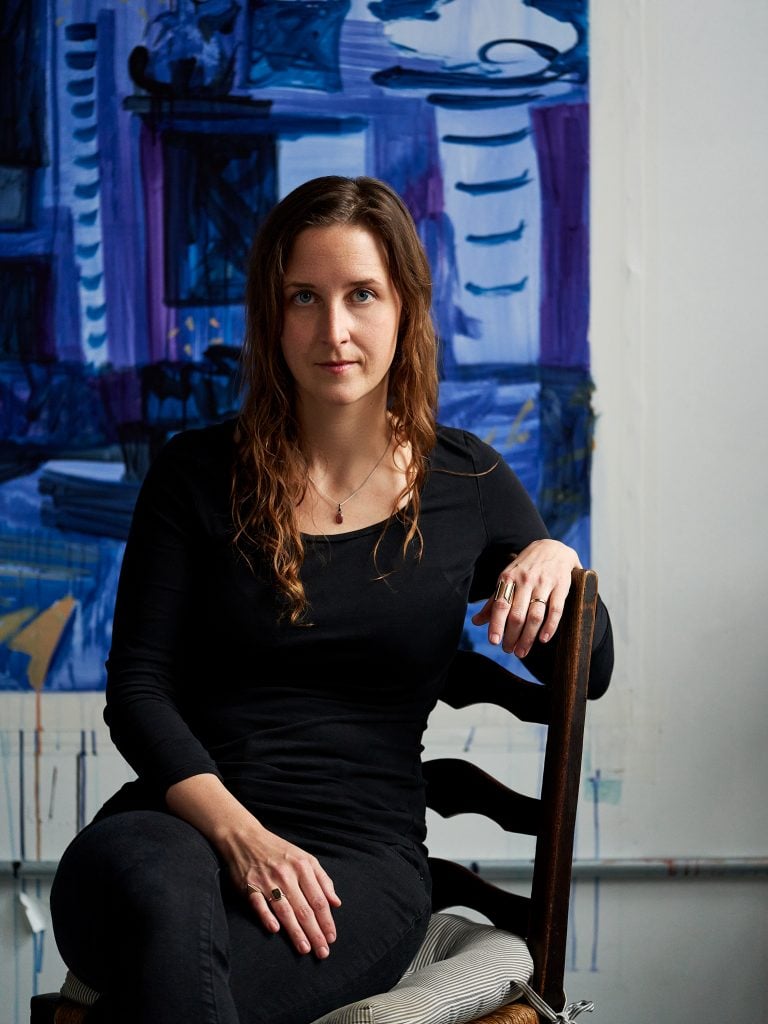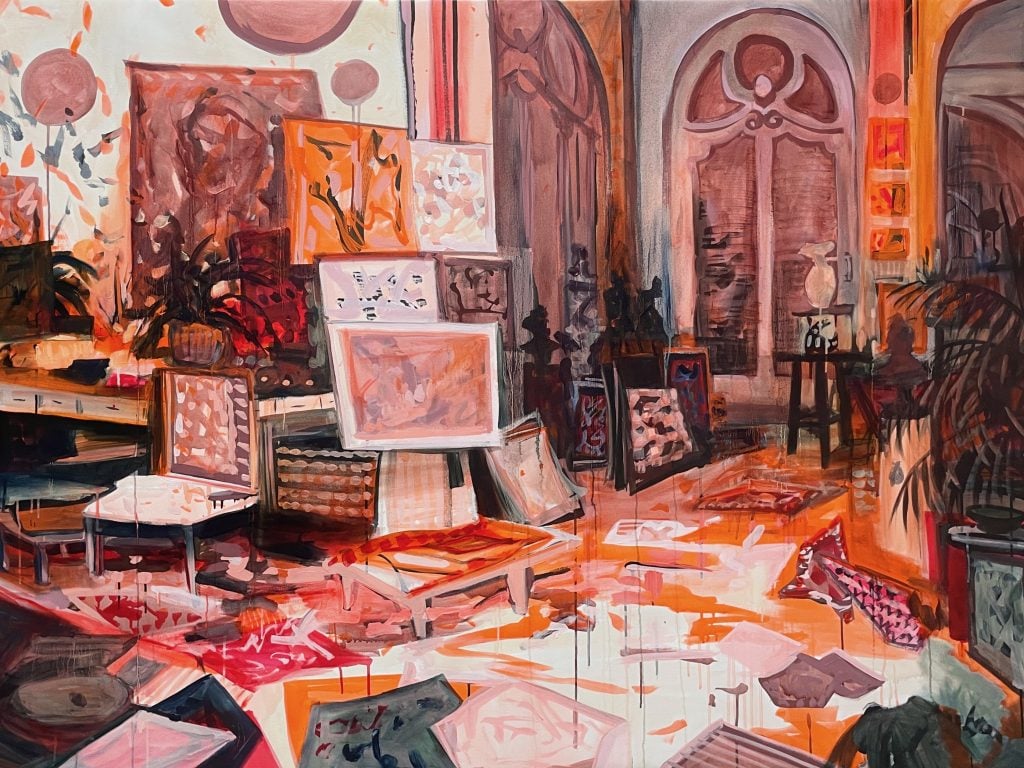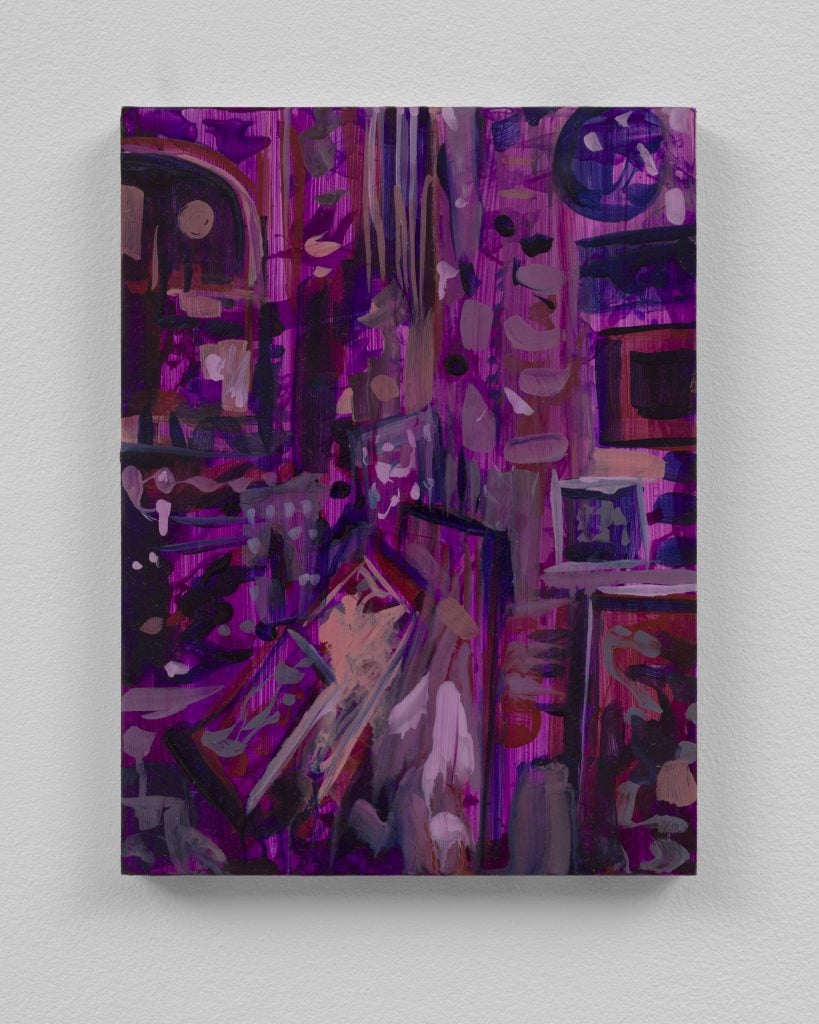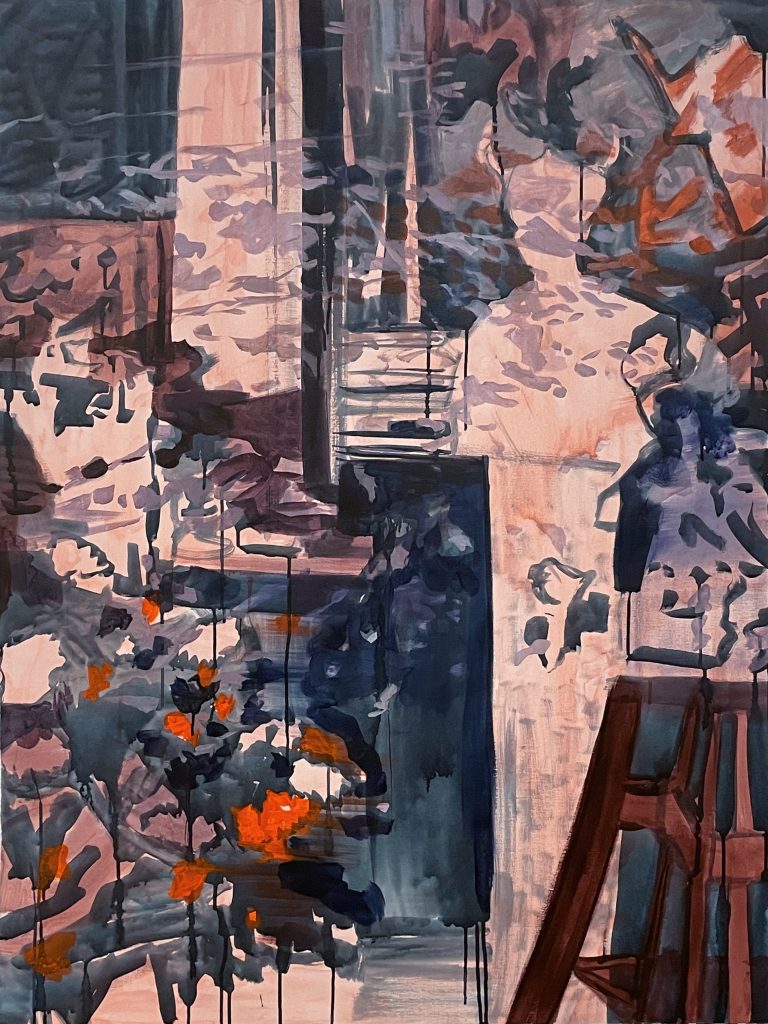Up Next
‘There Is a Sense of Being in a Tempest’: Inside Elizabeth Schwaiger’s Dream-Like Interiors
Nicola Vassell recently announced exclusive representation of Schwaiger.

Brooklyn-based artist Elizabeth Schwaiger paints opulent ruins where time takes on strange dimensions. Palatial rooms are cast in hues of purples, blues, and reds. Their walls are cluttered with paintings, some strewn across the floors. Houseplants overgrow their pots with abandon, seemingly flourishing in the absence of human life. Schwaiger debuted these works in her inaugural solo debut “Now & Now & Now” at Nicola Vassell Gallery in New York earlier this year.

Elizabeth Schwaiger, Ward for Abiding Hubris (2023). Courtesy of the artist and Nicola Vassell. Photo: Luke Brewer.
The artist, who was born in Texas in 1985, has been mining this lushly apocalyptic imagery for several years. Having earned an M.F.A. at the Glasgow School of Art in 2011, Schwaiger’s works, until recently, have been more broadly exhibited in the U.K. including exhibitions at the Walker Gallery National Museum in Liverpool, the Macintosh Museum in Glasgow, and the National Portrait Gallery in London. Last year, her work gained new exposure with a solo presentation at the Independent Art Fair presented by Nicola Vassell, and this January, the gallery announced its exclusive representation of her work. Schwaiger says her most recent works are her most introspective yet and are deeply informed by her experiences as a new mother.
“I made these works in the months after I gave birth to my daughter,” she said, during a recent conversation. “A baby’s schedule makes time very cyclical—she needed to eat, sleep, and back again. It was this reigning in of time.”

Elizabeth Schwaiger, Turning Towards the Void (2023). Courtesy of the artist and Nicola Vassell. Photo: Luke Brewer.
Much like the delirious days of new motherhood, the scenes in these paintings appear to exist outside the confines of night and day. Rather than emanating from a single source, light is dispersed in thin veils of watercolor, acrylic, ink, and oil on canvas. The passage of bright yellow, glowing reds, and deep blues can appear almost phosphorescent. Some of her paintings’ titles—Lingering Hours, The Rule of the Night, Unseasonably Still—hint at a sense of waiting or perhaps even of hiding from the world outside. Other works—Diving Into the Wreck, Permanent Intolerable Uncertainty, The Thunder Is the Thunder—suggest, on the other hand, a chaotic force already unfolding.
“Interiors can be a safe space that you create to keep the world at bay. The months since my daughter was born have felt like a push and pull between the outside world and the internal one. The world has become so porous. The apotropaic ways of warding off evil seem useless. There is a sense of being in a tempest,” the artist explained. “Before I was painting interiors that had something uncanny about them, but I’ve switched into this internal sublime, which is rooted in the awesome power of nature, but in the natural body I occupy.”

Installation view “Elizabeth Schwaiger: Now & Now & Now” 2024. Courtesy of Nicola Vassell. Photo: Luke Brewer.
But even amid wreckage or ruins, the paintings possess a purposeful slowness like underwater motion. In her experience of childbirth, Schwaiger found an analogous experience to her passion for scuba diving. “There’s a sense when you’re underwater that you don’t belong there, but even so you’re part of this ecosystem even if you’re not native to it.” she said “Water gives such a tactile atmosphere and you begin to realize you can control your depth based off of your breath. It’s intuitive and wild but it can also be a meditative experience.”
Several of the works in the exhibition allude to this aqueous imagery. One work, titled Salt and Sway takes its name from a line from Adrienne Rich’s poem “Diving into the Wreck” that reads: “the evidence of damage/ worn by salt and sway into this threadbare beauty/ the ribs of the disaster.”

Elizabeth Schwaiger, Salt and Sway (2023). Courtesy of the artist and Nicola Vassell. Photo: Luke Brewer.
Poetry is deeply influential to Schwaiger, too. “I think a lot about the Bertolt Brecht line, ‘What kind of times are these, when/ To talk about trees is almost a crime/ Because it implies silence about so many horrors?’” she explained, “But I think talking about a leaf or a tree can be a wonderful containment for all of these emotions and bigger feelings.” References to Rainer Maria Rilke and Mary Oliver also pop up.
“I often go back to poetry for a sense of understanding of the world that isn’t completely concrete. Poetry has the fluidness of the way that reality feels. Things can make poetic sense without making concrete sense. That’s what I hope my work has well—a dreamlike logic and a fluidity where things are always on the verge of changing,” she said “I think of trying to read in a dream and the letters are constantly rearranging. The paintings are a bit mercurial and difficult to pin down.”

Elizabeth Schwaiger, Unseasonably Still (2023). Courtesy of Nicola Vassell. Photo: Lance Brewer.
Even within the ever-shifting planes of Schwaiger’s paintings, it is possible to catch a glimpse of the artist herself, however fleeting. In the painting, Unseasonably Still (2023), Schwaiger’s image hovers spectrally amid plants and paintings. “This painting is based on a photograph with the reflection of me looking out the window, my apartment behind me, and gardens in front are all visible. It’s a mishmash between the two space and I’m caught in the middle of it,” she said “It’s very viscerally the past, present, and future colliding at once.”





